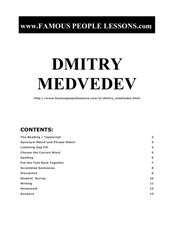Curated OER
The Most American Thing in America: The Chautauqua
Students explore the Chautauqua movement. For this Pennsylvania history lesson, students use primary documents to explore what the Chautauqua was and how it made a difference in the American way of life.
Curated OER
Locke's Second Treatise on Civil Government
In this online interactive history worksheet, students respond to 10 short answer and essay questions about Locke's Second Treatise on Civil Government.
Curated OER
Barack Obama
In this famous person worksheet, students read a passage about Barack Obama and then complete a variety of in-class and homework activities to support comprehension, including partner interviews, spelling, cloze, synonym matches, and...
Curated OER
Ban Ki-moon
For this famous person worksheet, students read a passage about Ban Ki-Moon and then complete a variety of in-class and homework activities to support comprehension, including partner interviews, spelling, cloze, synonym matches, and...
Curated OER
Dmitry Medvedev
In this famous person worksheet, students read a passage about Dmitry Medvedev and then complete a variety of in-class and homework activities to support comprehension, including partner interviews, spelling, cloze, synonym matches, and...
Curated OER
Food Insecurity
Explore food insecurity and resource scarcity with your class. They discuss the sharing of scarce resources, how to be good caretakers of these resources, and how choices impact the entire world.
Curated OER
One Dollar Around the World
Twelfth graders collaborate via ePals with another student from another country. They compare the value of a dollar with its power of acquisition in other countries. They list one dollar items and find the corresponding price in other...
Curated OER
The U.S. and Iran: Confronting Policy Alternatives
Students examine the relationship between the United States and Iran. In this global issues instructional activity, students research policy options the U.S. can take regarding Iran's desire to build more nuclear weapons.
Curated OER
Sense of Hearing
Create a graphic organizer to review parts and systems of the body, then present a new topic. Special education students grades 3-5 learn about the sense of hearing. They draw parts of the ear, sign a song, read Perk Up Your Ears, and...
Curated OER
The Beagle Brigade
Students develop an understanding of animal behaviors through reading a case study about detector beagles. They explore the interaction of innate abilities and learned behaviors.
Curated OER
Exploring the Global Security Matrix
Using online and newspaper resources, small groups explore the issue of global security. They answer 13 different questions on three pages that have them consider multiple risks posed by a global security system.
Curated OER
"A Typical Day at Seaworld" one day visit
Explore the business side of careers in zoological or marine parks. Learners use the internet, field trips, and their research skills to develop an understanding of what skills are needed to work in an animal park environment.
Curated OER
A Village of Painters: Narrative Scrolls from West Bengal
Examine the process of making Indian patua-style narrative scrolls. Look closely at the images in the scrolls and have your young artists create an original patua painting. Using ink and watercolors, the class can illustrate their...
Curated OER
It's Up for Debate
Young scholars work together to research issues surrounding World War II. They review the decisions that were made at the time. They participate in a debate and how those decisions maintained world peace.
Pennsylvania Department of Education
Shapes Around Us
Learners use manipulatives to study shapes. They sort shapes and use correct geometric terminology to describe them. Students find real-life examples of 2 and 3 dimensional shapes, and classify figures in their classroom according to...
Curated OER
Globalization and Health
Students explore the threat of global health issues. For this globalization lesson, students read the noted articles about diseases that have morphed through globalization. Students then participate in classroom simulation that requires...
Curated OER
Breathing and Holding Your Breath
Five questions are presented and answered as a means of delivering information on the respiratory system. Using red and blue game chips, physiology learners model the movement of blood through the lungs. Groups of learners time how long...
Curated OER
Importance of American Flag in American Literature
Betsy Ross - fact and myth. As an introduction to American Literature, class members become detectives and search web sites to find information about the flag, prominent places it has been displayed (on the moon, at ground zero, in...
Illustrative Mathematics
Growing Coffee
Ask your algebra learners to write an equation that has unit constraints. This commentary talks about the constraints, but does not show them in the equation. It is important that your mathematicians understand that the units apply to...
Curated OER
Planning a Government
Demonstrate the complexities of running a government with this group activity. Young politicians are arranged into small groups and become leaders of a hypothetical country (outline of country provided). Groups must outline 6 (listed)...
Curated OER
Fairy Dictionary
Use artwork to illicit responses in a writing journal, and then present your class with the short list of key terms provided. Can your learners add any of their own key terms? Segue for a second, and read tales such as Peter Pan or...
Curated OER
Ellipses and Kepler's First Law
The class examines graphs in the form r = F(¿¿) in polar coordinates (r, ¿¿), in particular with the circle, ellipse and other conic sections. They determine the nature of an ellipse by studying the role of the semimajor axis and...
Curated OER
Plotting A Hurricane Using latitude and Longitude
Students explore map and plotting skills by tracing the movement s of hurricanes through the Earth's systems. a hurricane map is developed from daily media reports.
Curated OER
Sectionalism in Early U.S.
Students, divided into three groups, representing the Northeastern, Southern, Western United States. They research these areas in early American history and as a group prepare charts, graphs and reports. They explain their needs and...

























